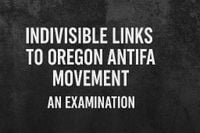On October 8, 2025, the White House became the stage for a heated and revealing roundtable as officials, journalists, and watchdogs gathered to dissect the funding and organization behind Antifa and similar radical left-wing groups. The event, attended by figures such as Seamus Bruner, Research Director at the Government Accountability Institute (GAI), and journalist Katie Daviscourt, underscored a growing national debate: where does the money fueling street protests and violent unrest actually come from, and how deep do these networks run?
Bruner, speaking to reporters and administration officials, didn’t mince words. “We followed the money, and we followed it to the top of what we call the protest industrial complex,” he said, as reported by The Post Millennial. Bruner described a sprawling, corporate-style operation he dubbed ‘Riot Inc.’—a network of non-governmental organizations (NGOs) and activist groups that, he claims, not only organizes and supports Antifa cells across the United States but also provides them with legal, marketing, and public relations muscle.
According to Bruner and GAI’s investigations, the web of financial support is both vast and complex. It’s not just the widely discussed Soros Open Society network, but also the Arabella Funding Network, the Tides Foundation, and the networks of billionaire Neville Roy Singham. Foreign money, too, plays a role—Bruner specifically named Swiss citizen Hansjörg Wyss as a significant contributor. “They’re pouring money into this entire ecosystem,” Bruner asserted, emphasizing that these aren’t isolated donations, but part of a coordinated system to keep activist groups well-resourced and, crucially, legally protected.
Perhaps the most eyebrow-raising revelation from the roundtable was Bruner’s claim that more than $100 million in U.S. taxpayer funding has flowed into these networks, including at least $4 million directly to groups involved in protest violence. “Not just Antifa types, but there was an event in Atlanta called Stop Cop City. Over 60 rioters were charged with domestic terrorism. These groups received money for that from both the billionaire class as well as taxpayer money,” Bruner said, as cited in The Post Millennial.
The mechanics of this funding are modern and nimble. Crowdfunding platforms, Bruner explained, are routinely used to shuttle money to Antifa cells, the John Brown Gun Club, and other activist collectives. The result is a movement that, while often described as decentralized and spontaneous, is in reality undergirded by a sophisticated infrastructure designed to keep activists on the streets and out of jail.
The Trump administration, for its part, has seized on these findings to renew calls for a crackdown. On the same day as the roundtable, the White House released a video featuring Attorney General Pam Bondi, pledging to investigate and halt political violence associated with Antifa. The administration’s message was clear: tracing the money is the key to unmasking and dismantling the networks behind the unrest.
Katie Daviscourt, one of the journalists attending the roundtable, brought a personal dimension to the proceedings. She recounted a recent assault by Antifa militants in Portland, Oregon, describing how she was left with a black eye and a concussion after being struck with a metal pole. “I watched 20 Antifa militants help my assault suspect into an Antifa safehouse that is one block away from the ICE facility,” Daviscourt told the group, underscoring the organized nature of these operations.
GAI’s research, as highlighted by Bruner, also points to coordinated activity in cities such as Portland, Seattle, and Chicago. Investigators found that individuals were paid and transported to participate in unrest, suggesting a level of orchestration that belies the image of Antifa as a leaderless or purely ideological movement. Bruner called for federal agencies, including the IRS and the Office of Management and Budget, to review or revoke the tax-exempt status of nonprofits misusing funds, and suggested that RICO statutes could be applied to target the broader networks.
Yet, the political and cultural debate over Antifa’s very existence rages on. Just a day after the roundtable, ABC late-night host Jimmy Kimmel used his platform to mock the notion of Antifa as an organized threat. “You understand, there is no Antifa? This is an entirely imaginary organization,” Kimmel quipped, likening the group to fictional villains. His comments reflect a common refrain among some left-leaning commentators: since Antifa lacks a central office or hierarchy, it is more of an idea than an organization—a claim that, according to GAI’s findings, doesn’t hold up against the financial and organizational evidence.
Bruner, in response to such skepticism, pointed to the “money trail” as proof of Antifa’s existence as a networked movement. “We found a network of NGOs… it’s not just the Soros network, the Open Society Network. It’s other funding networks, the Arabella Funding Network, the Tides Funding Network, Neville Roy Singham and his network, foreign cash, and it’s also big left-wing funders—some of them are not citizens of this country,” he told Breitbart News. Bruner detailed how these funds flow into dozens of radical organizations, supporting everything from legal defense to public relations campaigns.
The question of how these networks operate at the local level was explored in depth by the Yamhill Advocate, an independent newspaper in Oregon. Over several years, the Advocate’s investigation into activist groups in Yamhill County—particularly the Progressive Yamhill chapter of the national Indivisible organization—revealed how local chapters serve as conduits for funding, recruitment, and organization. According to the Advocate, Indivisible’s Oregon chapters have become primary means for Antifa’s local operations, with state and national leadership sending down “actions” and funding to city- and county-level groups. The result is a chain of command that, while disguised as grassroots activism, is tightly coordinated and well-resourced.
The Advocate’s reporting also connects Antifa’s decentralized structure to the broader ideology of “Wokeism,” rooted in New Left philosophy and social justice activism. Critics argue this ideology, while promoting equality and anti-racism, can lead to cultural policing and performative activism. Supporters, meanwhile, see it as a necessary corrective to systemic injustice. The debate is far from settled, but what’s clear is that the infrastructure supporting these movements is more robust—and more deeply entwined with political and nonprofit networks—than many realize.
Calls for federal investigation have grown louder, with independent journalists and watchdogs urging agencies like the FBI to take a hard look at how funds move through these networks. The Yamhill Advocate’s editor, who provided archived group messages to the FBI during the Biden administration, expressed frustration at the lack of action but remains hopeful that renewed scrutiny will finally yield results.
As the political season heats up and the nation grapples with questions of protest, violence, and accountability, the revelations from this week’s roundtable and investigative reports have thrown a spotlight on the shadowy financial and organizational machinery behind Antifa and its allies. Whether these findings will lead to meaningful reform or further partisan division remains to be seen, but the conversation about who funds unrest—and why—has never been more urgent or more necessary.


